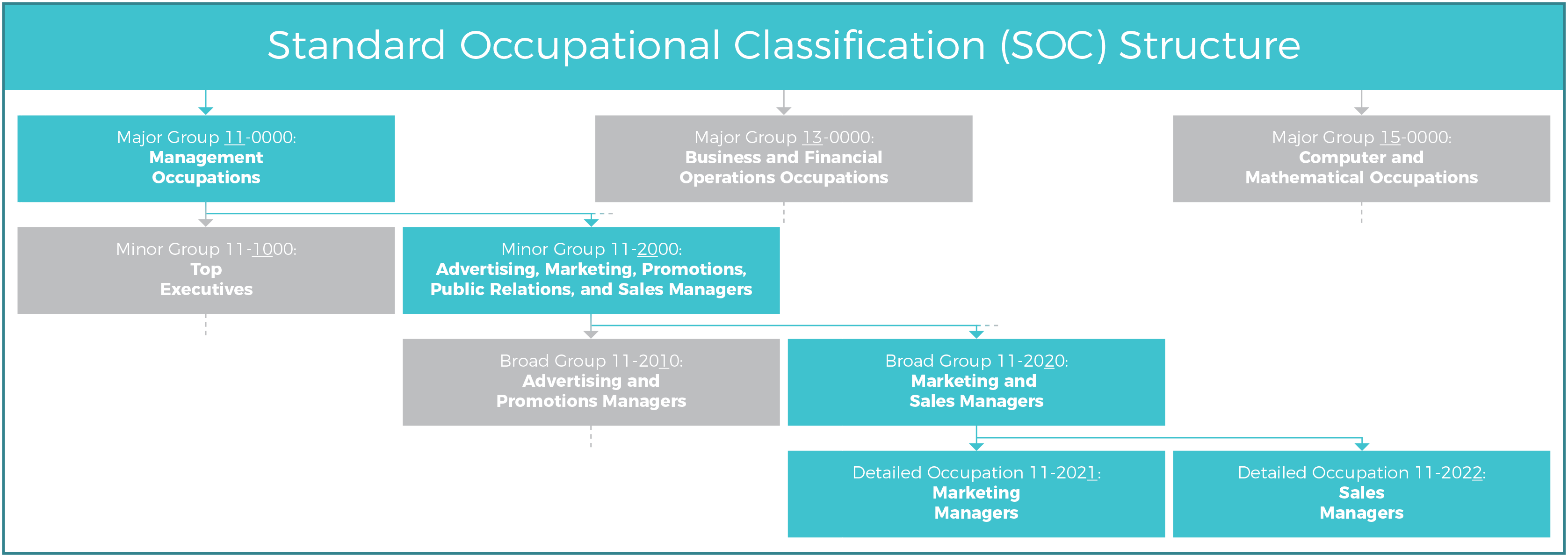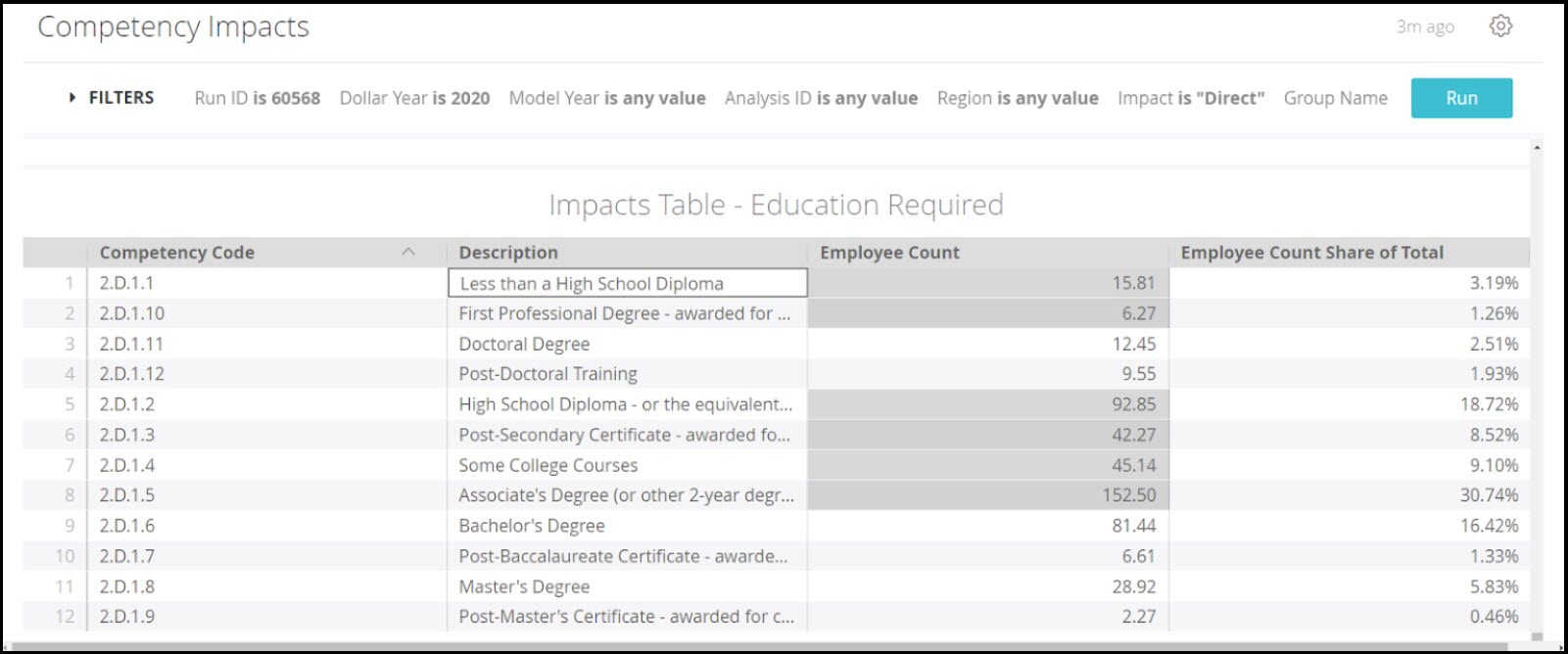The most granular employment insight IMPLAN has ever assembled and organized by occupation and core competency is now available for purchase inside the IMPLAN application. Our occupation data shows estimates of employment, wages, hours, and core competencies for 823 different occupations. What you find in the data and how can it be leveraged in your own studies can be a game-changer.
What are the Components of the Occupation Data?
Occupation Data can be useful to you whether you intend to run an analysis or simply access the data itself. Without conducting an impact, the underlying data itself provides the occupations, wages, and core competencies that are already present in the Region you are studying. When conducting an impact, the Occupation Impact Data shows the occupations, wages and core competency effects generated by your specific impact or contribution. These insights are present in the results after running your analysis.
So what values will you find in this data? The following data points can be found for the region as a total, by occupation, and by industry.
Occupation Employment
Consistent with the Bureau of Labor Statistics (BLS), the employment value is representative of all part-time and full-time workers who are paid a wage or salary and does not include proprietors. Occupations correspond to the Standard Occupational Classification (SOC) codes applied by the BLS.

Occupation Compensation
Compensation includes wages and salary, supplements to wages and salary, and employee compensation for any given occupation.
Occupation Hours Worked
Occupation hours worked data is a yearly total that accounts for part-time employment in some occupations in a given industry.
Here you will find totals for employment, compensation, and hours worked data, as well as average values (i.e. average employee compensation per employee, average hours per employee, average employee compensation per hour, etc.).
Core Competencies
Core competencies consist of Knowledge, Skill, and Ability (KSA) elements as well as required education levels, work experience, and on-the-job training using data from BLS and O*NET™. O*NET™ data reports 33 unique knowledge elements, 35 unique skill elements, 52 unique ability elements, 12 unique educational attainment elements, 11 unique work experience levels, and 9 unique on-the-job training levels. Descriptions of these core competency elements can be downloaded here.
How Can You Use Occupation Data?
IMPLAN users are constantly finding novel and insightful ways to use our data and application. Occupation Data creates greater opportunity to gain deeper insights into your economy.
Developing Targeted Job Training Initiatives
Preparing the local workforce to fill the jobs that local businesses have open (or will have open in the future) can help close the economic loop within a regional economy. Whether it is the local community college, job skills training programs, or vocational upskilling programs it’s important that there is alignment between the training received by workers and the skills needed by local businesses. Occupation Data can be utilized to demonstrate how a community can evaluate the types of jobs in the local economy, the skills needed to fill those jobs, and the expected wages of those jobs so that local education partners can train people to fill them and keep more talent, more businesses, and more money in the local economy.
Employment Requirements: New Business Operations
Whatever your impact or contribution, one of the most valuable ways to tell your story comes from the jobs your activity supports. Whether it’s by directly employing people, the jobs your activity supports through your supply chain, or through jobs supported by wage spending, jobs are one of the most tangible and important measures of your impact or contribution.
As an example, let’s consider a new, state-of-the-art, hospital being built in an underserved urban area. Once the hospital is finished, it will employ 500 workers. The company building and operating the hospital would like to show the County Board of Commissioners what the economic impact will be of the operations of the hospital. The Board of Commissioners has said that in addition to creating economic impacts, they will need to show that at least 40% of the 500 expected jobs (or at least 200 jobs) at the hospital will go to workers who have education levels less than a bachelor’s degree in order to qualify for certain requirements for tax exemptions.
After setting up and running your impact analysis, you can use the Occupation Data to determine the education level of the workers expected for the hospital. The Core Competencies on the Results tab of your analysis shows the distribution of the education levels of the Direct jobs.

This insight is also identifiable for all jobs through the supply chain and supported through the spending of wages (i.e. Direct, Indirect, and Induced jobs). This exceptional insight provides all the answers required to fulfill any requirements laid out by the Board of Commissioners and would be useful for any business or economic development organization seeking grants or incentives ahead of a large project.
Evaluating Different Occupation Opportunities (NMTC)
New Market Tax Credits (NMTC) are powerful incentives that the economic development community uses to entice new businesses or encourage business retention. However, it can be difficult to understand what different opportunities bring to the local economy. With Occupation Data, analysts can compare two (or more) economic development opportunities in terms of the numbers, types, and wages of the occupations that would be expected to accompany them.
Using this type of analysis can help guide local development groups towards policies that are more aligned with their stated goals beyond merely supporting jobs. The education requirements, average annual wage, and hours worked provide greater understanding of the true value of proposed projects to a community.
Business Site Selection
As organizations look to expand, locate, or relocate, one of the primary questions they must answer is how prospective areas match the labor force needs of the business. That is, are the workers needed by the business available in the area? What are the differences in wages between workers in one area versus another? The answers to these questions often play a crucial role in the decision-making process for businesses evaluating location decisions.
This type of analysis provides the businesses with data upon which to make sound planning decisions about where the new operation should be located. This analysis was demonstrated in our webinar, Exploring Occupation Data in IMPLAN, and can be viewed here.
Wrapping IT Up
For more than 40 years, IMPLAN has pushed the boundaries of economic investigation and equipped analysts with the tools and data they need to explore, discover, and analyze their economy. Occupation Data is the latest step in our effort to provide technology for unlocking economic opportunity. Whether you are interested in simply diving into your own underlying economic values or quantifying an economic impact for site selection or incentive applications, this dataset offers the most comprehensive portrait of the workforce in any region.



.png?width=80&name=IMPLAN_Logo_Print-Vector_NEW%20(2).png) Copyright 2025
Copyright 2025